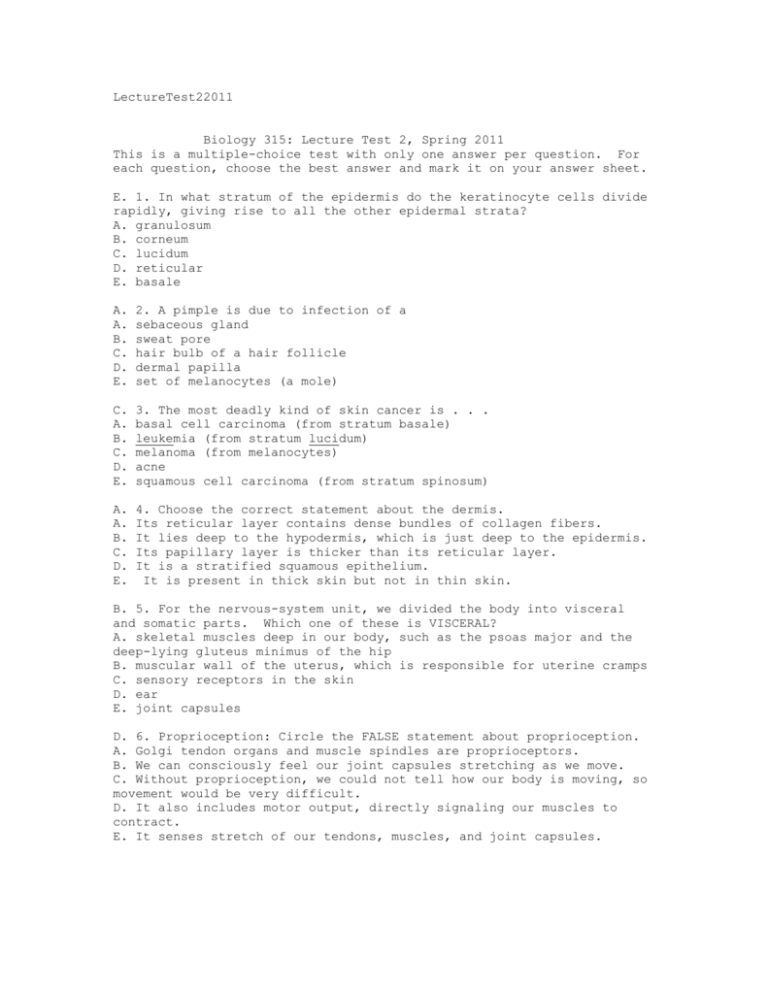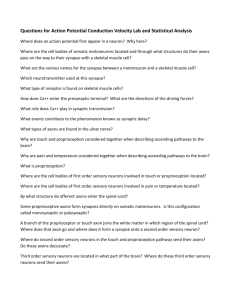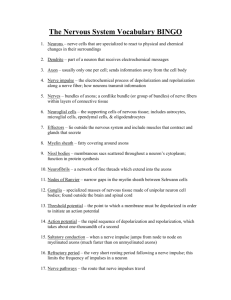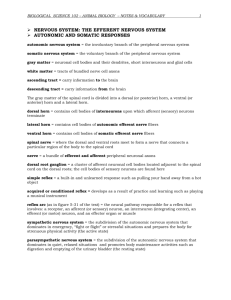Lecture Test 2 2011
advertisement

LectureTest22011 Biology 315: Lecture Test 2, Spring 2011 This is a multiple-choice test with only one answer per question. For each question, choose the best answer and mark it on your answer sheet. E. 1. In what stratum of the epidermis do the keratinocyte cells divide rapidly, giving rise to all the other epidermal strata? A. granulosum B. corneum C. lucidum D. reticular E. basale A. A. B. C. D. E. 2. A pimple is due to infection of a sebaceous gland sweat pore hair bulb of a hair follicle dermal papilla set of melanocytes (a mole) C. A. B. C. D. E. 3. The most deadly kind of skin cancer is . . . basal cell carcinoma (from stratum basale) leukemia (from stratum lucidum) melanoma (from melanocytes) acne squamous cell carcinoma (from stratum spinosum) A. A. B. C. D. E. 4. Choose the correct statement about the dermis. Its reticular layer contains dense bundles of collagen fibers. It lies deep to the hypodermis, which is just deep to the epidermis. Its papillary layer is thicker than its reticular layer. It is a stratified squamous epithelium. It is present in thick skin but not in thin skin. B. 5. For the nervous-system unit, we divided the body into visceral and somatic parts. Which one of these is VISCERAL? A. skeletal muscles deep in our body, such as the psoas major and the deep-lying gluteus minimus of the hip B. muscular wall of the uterus, which is responsible for uterine cramps C. sensory receptors in the skin D. ear E. joint capsules D. 6. Proprioception: Circle the FALSE statement about proprioception. A. Golgi tendon organs and muscle spindles are proprioceptors. B. We can consciously feel our joint capsules stretching as we move. C. Without proprioception, we could not tell how our body is moving, so movement would be very difficult. D. It also includes motor output, directly signaling our muscles to contract. E. It senses stretch of our tendons, muscles, and joint capsules. A. 7. In a simple, three-neuron reflex arc, which neuron directly signals the muscle to contract or the gland to secrete? A. efferent neuron B. pseudounipolar neuron C. sensory neuron D. interneuron E. afferent neuron D. 8. Central nervous system (CNS) and peripheral nervous system (PNS). Circle the WRONG statement. A. Gray matter contains short interneurons and it makes complex calculations. B. The sympathetic trunk ganglia are in the PNS. C. The brain is part of the CNS. D. Dorsal root ganglia are in the CNS. E. Nerves are only in the PNS. E. 9. Birth defects. Which of these neural-tube defects is similar to spinal rachischisis (in which the neural groove never closes), except that it involves the brain? A. spina bifida occulta B. hydroencephalus C. meningocoele D. myelomeningocoele E. anencephaly E. 10. Axons versus dendrites: How did we define these two processes in class? A. Axons are postsynaptic, but dendrites are presynaptic. B. An axon is the thicker process, the dendrite is thinner. C. Axons attach to the cell body of a neuron, but dendrites do not (that is, dendrites only attach to the base of an axon). D. Axons participate in synapses, but dendrites, by definition, do not. E. An axon carries action potentials away from the cell body and a dendrite carries graded potentials toward the cell body. C. 11. Nervous tissue: Circle the only TRUE statement about nerves, nerve fibers, or neurons. A. A nerve is the same as a neuron. B. A nerve fiber is a complete nerve cell. C. Thick nerve fibers are myelinated but thin fibers are not. D. A nerve fiber contains many nerves. E. A nerve (bundle of axons) is the same thing as a tract (bundle of axons) because both are in the PNS. D. A. B. C. D. E. 12. What makes up Nissl substance in the cell bodies of neurons? lysosomes (autophagosomes) filled with partly digested organelles clusters of mitochondria rolled, concentric layers of plasma membrane rough endoplasmic reticulum and free ribosomes neurofibrils, which consist of neurofilaments Key 13-16. For the next four questions, refer to the first diagram on the picture page, and choose A, B, C, D, or E from that diagram. C. 13. This is a dorsal root. A. 14. This is a spinal nerve. E. 15. The dorsal gray horn B. 16. Dorsal root ganglion Key 17-20. For the next four questions, refer to the second diagram on the picture page, and choose aa, bb, cc, dd, or ee from that diagram. For aa mark A on your answer sheet, for bb mark B, etc. B. 17. Ventral ramus A. 18. Consists of preganglionic sympathetic axons. E. 19. Damage to the white matter here leads to loss of conscious feelings of pain, temperature, and coarse touch on the skin. C. 20. Ependyma D. 21. Supporting cells in the nervous system. Choose the WRONG statement. A. Microglia are macrophages in the CNS. B. Astrocytes help synapses to work better. C. Astrocytes control ion concentrations in the fluid around the nerve cells. D. Satellite cells and Schwann cells are two kinds of neuroglia in the CNS. E. The function of oligodendrocytes relates more to white matter than to gray matter in the CNS. E. 22. Refer to the drawings of the cross sections through the spinal cord and brain on the picture page, and choose the correct arrangement of functional zones of the gray matter, from #1 to #4. (Note: the arrangement is the same for both the spinal cord and the brain.) A. 1=VS, 2=SS, 3=VM, 4=SM B. 1=VM, 2=SM, 3=VS, 4=SS C. 1=VS, 2=SS, 3=SM, 4=VM D. 1=SM, 2=VM, 3=SS, 4=VS E. 1=SS, 2=VS, 3=VM, 4=SM C. 23. Unlike the other parts of the brain and the spinal cord, the forebrain (telencephalon and diencephalon) never develops a basal plate. This means the telencephalon and diencephalon do not contain any . . . (Hint: Think what the basal plate gives rise to.) A. sensory neurons attached to them B. interneurons C. motor neurons D. choroid plexus E. ventricles A. 24. Gray matter in the brain. Which one of these is NOT gray matter? A. inferior cerebellar peduncle, containing the spinocerebellar tract B. cerebral cortex C. ventral posterior lateral nucleus of the thalamus D. nucleus accumbens (pleasure and reward center) of the limbic lobe E. nuclei of the cranial nerves B. 25. Sensory inputs and motor outputs. Circle the FALSE statement. A. Vision is special somatic sensory. B. Feeling gas pains in your intestine is general somatic sensory. C. When you close your eyelids or raise your eyebrows, the signal to the muscles is branchial motor. D. Feeling a mosquito that lands on the skin of your arm and bends a hair is general somatic sensory. E. Signalling the bladder wall to contract is both general visceral motor and parasympathetic. A. 26. What is the receptor for fine touch in the lips, palms, and soles? A. Meissner’s corpuscle B. Pacinian corpuscle C. Golgi tendon organ D. muscle spindle E. unencapsulated nerve ending B. 27. Sensory pathways. Choose the FALSE statement. A. The sensory information carried by the spinothalamic and dorsal column pathways comes to our consciousness, but sensory information carried by the spinocerebellar pathway does not. B. In the dorsal column patahway, the axons of the first neurons are in the white matter of the cerebrum. C. In the spinothalamic pathway, the cell bodies of the second neurons are in the gray matter of the spinal cord. D. In the gustatory (taste) pathways, the cell bodies of the third neurons are in the thalamus. (Hint: you can deduce this from the general rules that we gave.) E. In the visual pathway, the axons of the ganglion neurons are in the optic nerve and optic chiasma. C. 28. What is an example of somatotopy? A. Some kinds of stimuli cannot be localized precisely on our skin, and they also make us angry (the affective senses). B. A chain of three neurons (not just one neuron) carries information on touch from the skin of the body to the cerebral cortex. C. The homunculus (“distorted little man”) on the primary motor cerebral cortex. D. When we cut our left hand, this is consciously felt by the right cerebral hemisphere. E. The somatic part of the body lies external to the inner, visceral part. E. 29. A functional MRI scan is being performed on a woman who is listening carefully to the tones of a song, but after a while she panics because the MRI device is too confined and claustrophobic. Which parts of her brain show the most activity in the MRI images? A. much of the occipital lobe, then the prefrontal cortex B. the uncus and nearby parts of the medial temporal lobe C. the posterior part of the frontal lobe, just anterior to the precentral gyrus; then the hippocampus D. anterior parietal lobe and insula E. the temporal lobe near the lateral sulcus (lateral fissure), then the amygdala E. 30. As presented in lecture, which brain structure associated with our behavior does not mature until surprisingly late, at about age 25? A. limbic system B. reticular-activating system C. hippocampus D. cortex of cerebellum E. prefrontal cerebral cortex E. 31. What is NOT a characteristic of the basal nuclei (basal ganglia)? A. involved in Parkinson’s disease B. involved in habits and in “instinctual” behavior patterns C. help to start, stop, and regulate the intensity of our voluntary movements D. work together with the primary motor cerebral cortex E. are the main visceral control center of the brain D. A. B. C. D. E. 32. The limbic system . . . (Circle the WRONG answer). is active when we are emotional. includes the limbic lobe of the telencephalon, which is ring-shaped. includes the hypothalamus. moves our limbs (= “limb-ic”), not our trunk. influences our visceral functions, such as digestion. B. 33. Locations of brain structures. Circle the CORRECT one. A. Thalamus is in the telencephalon. B. The fourth ventricle is in the myelencephalon. C. The only part of the brain stem that contains the reticular formation is the medulla. D. Inferior colliculi are in the diencephalon. E. The cerebellum is a part of the mesencephalon. D. 34. Which is NOT a characteristic of the pyramidal tract? A. Some of its axons synapse in the pontine nuclei of the pons. B. Carries voluntary motor information. C. Issues from the primary motor cerebral cortex and the pre-motor cortex. D. Does not cross over from right to left (and vice-versa), because only ascending sensory pathways cross over. E. On the ventral brain stem it forms the crus cerebri and the pyramids. D. 35. In this course, we learned the names of only five specific types of neurons. Which one of them is most important for the cerebellum, in calculating how to make our movements smooth, precise, and coordinated? A. pseudo-unipolar neuron B. pyramidal neuron C. ganglion neuron D. Purkinje neuron E. bipolar neuron A. 36. Most OUTPUT from the cerebellum, telling how to smooth and coordinate our movements, goes to the . . . A. primary motor cerebral cortex B. directly to motor neurons in the spinal cord C. medial geniculate nucleus of the thalamus D. interneurons in the spinal cord E. spinocerebellar tract C. 37. A mixed cranial nerve, such as the facial, trigeminal, glossopharyngeal, or vagus, contains all these things EXCEPT for . . . A. branchial motor axons B. general somatic sensory axons C. somatic motor axons D. sensory ganglion E. visceral sensory axons B. A. B. C. D. E. 38. Which cranial nerve innervates almost all the skin of the face? facial trigeminal vestibulocochlear trochlear vagus B. A. B. C. D. E. 39. Which cranial nerve signals movements of the tongue? facial hypoglossal trigeminal glossopharyngeal accessory B. 40. Choose the correct match between the cranial nerve and its number. A. optic = 1 B. oculomotor = 3 C. abducens = 4 D. glossopharyngeal = 12 E. facial = 5 D. 41. Circle the TRUE statement about the parasympathetic division of the autonomic nervous system. A. It is for “fight, fright, or flight.” B. It is thoraco-lumbar. C. Its preganglionic axons are shorter than its postganglionic axons. D. The vagus nerve contains many preganglionic parasympathatic axons. E. Its postganglionic neurotransmitter is usually norepinephrine (=noradrenaline). C. 42. The lateral gray horn of the thoracic spinal cord contains what kind of autonomic cell bodies? A. preganglionic parasympathetic B. postganglionic parasympathetic C. preganglionic sympathetic D. postganglionic sympathetic D. 43. Parasympathetic versus sympathetic division of the ANS: Choose the FALSE statement. A. The parasympathetic causes cardiac muscle to contract slower, but sympathetic causes it to contract faster. B. Sympathetic causes our hair to stand up, but parasympathetic has no effect on this. C. Parasympathetic causes glands in our stomach and intestine to secrete digestive juices, but sympathetic inhibits this secretion. D. Parasympathetic makes the adrenal medulla secrete adrenaline, but the sympathetic inhibits this secretion. E. Sympathetic dilates (widens) the air tubes in the lungs, but parasympathetic constricts (narrows) them. C. 44. A thoracic splanchnic nerve (from a trunk ganglion), contains ____________ ____________ axons: A. preganglionic parasympathetic B. postganglionic parasympathetic C. preganglionic sympathetic D. postganglionic sympathetic D. A. B. C. D. E. 45. What are three parts of the vascular tunic of the eyeball? cornea, sclera, scleral venous sinus aqueous humor, lens, vitreous body neural layer of retina, central artery and central vein of retina iris, ciliary body, choroid anterior chamber, posterior chamber, posterior segment B. 46. Choose the correct order of signals in the visual pathway. A. optic nerve to photoreceptors to thalamus to ganglion neurons to primary visual cortex B. rod and cone cells to bipolar neurons to ganglion neurons to thalamus to primary visual cortex C. photorecepters to ganglion neurons to bipolar neurons to optic chiasma to thalamus to superior colliculus D. optic tract to optic nerve to cerebellum to cerebral cortex to basal nuclei E. optic papilla to ganglion neurons to photorecepters to retina A. 47. Middle ear. Circle the FALSE statement. A. The spiral organ of Corti is in the middle ear (tympanic cavity). B. The pharyngotympanic tube functions to equalize air pressure across the eardrum. C. The middle ear cavity is in the petrous part of the temporal bone of the skull. D. The ossicles in the middle ear function to amplify sounds. E. The footplate of the stapes fits into the oval window. A. 48. In which part of the inner ear are the hair cells associated with an otolithic membrane, with ear stones, to measure linear acceleration and static equilibrium of the head? A. utricle B. ampulla C. cochlear duct D. semicircular canal E. scala tympani B. 49. In the spiral organ of Corti, the hair cells directly touch all these things, EXCEPT for . . . A. tectorial membrane B. perilymph C. endolymph D. basilar membrane E. nerve endings from the cochlear part of the vestibulocochlear nerve E. or A. B. C. D. E. 50. Which one of these is NOT part of the auditory (hearing) system the auditory pathway? Brodmann’s areas 41 and 42 in the temporal lobe’s cerebral cortex. inferior colliculus cochlear part of the vestibulocochlear nerve medial geniculate nucleus of the thalamus vestibular nuclei in the medulla oblongata








